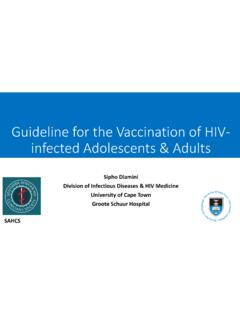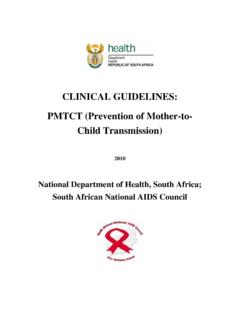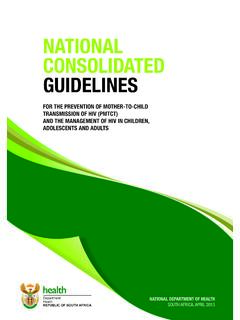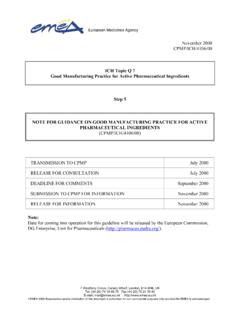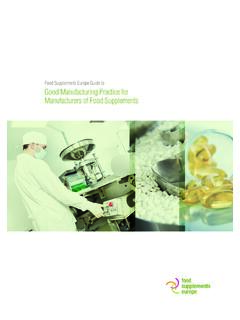Transcription of SA GUIDE TO GOOD MANUFACTURING PRACTICE FOR …
1 good MANUFACTURING practices SA GUIDE to GMP GUIDE to good MANUFACTURING Practice_Jul19_v97 July 2019 Page 1 of 18 Back to ToC SA GUIDE TO good MANUFACTURING PRACTICE FOR MEDICINES This document is intended to serve as guidance on the requirements for good MANUFACTURING PRACTICE (GMP) in South Africa. This guideline is not intended as an exclusive approach. SAHPRA reserves the right to request any additional information to establish the safety, quality and efficacy of a medicine. SAHPRA may make amendments in keeping with the knowledge which is current at the time of consideration of data accompanying applications for registration of medicines. Alternative approaches may be used but these must be scientifically and technically justified. SAHPRA is committed to ensure that all medicines gaining market approval will be of the required quality, safety and efficacy standards. Version 1 Implementation 1997 Version 1 Chapter 9 (Validation) reformatted January 2004 Version 2 Adoption of PIC/S GMP GUIDE of July 2004 January 2006 Version 3 Updates to Sections in line with PIC/S GUIDE updates September 2008 Released for comment 31 January 2009 Version 4 Amendments to Annexes 3 & 7 March 2009 Released for comment 30 June 2009 Version 5 Consolidation of comments on versions 3 & 4 November 2010 Version 6 Adoption and acknowledgement of future adaptations of the PIC/S GUIDE to GMP December 2017 Version 7 Amendments to section 3 and addition of Annex 17 & 18 July 2019 good MANUFACTURING practices SA GUIDE to GMP GUIDE to good MANUFACTURING Practice_Jul19_v9 December 2017 Page 2 of 18 TABLE OF CONTENTS Page 1 INTRODUCTION.
2 4 2 ADOPTION AND ADAPTATION OF THE PIC/S GMP GUIDE .. 4 3 REGULATORY PROCESSES .. 4 PRINCIPLES .. 4 GMP approval guidance .. 5 4 ANNEX 16 SOUTH AFRICAN SPECIFIC REQUIREMENTS: ORGANISATION & PERSONNEL 5 PRINCIPLES .. 5 RESPONSIBILITIES OF KEY PERSONNEL .. 6 LEGAL ASPECTS .. 8 Definitions .. 8 Pharmacy Act (Act 53 of 1974) & Regulations (Pharmacy Act) .. 8 Medicines and Related Substances Act (Act 101 of 1965) & Regulations (Medicines Act) .. 9 Pharmaceutical Companies .. 10 Narcotics/Psychotropics .. 10 QUALIFICATIONS .. 11 TRAINING .. 11 HYGIENE .. 12 Personal Hygiene .. 12 Area Control .. 12 Medical Checks .. 13 5 Appendix 1 Recognised regulators .. 13 6 Appendix 2 Dosage, product type and activity groupings .. 16 Holder of registration certificate .. 17 Export .. 17 Import .. 17 MANUFACTURING section .. 17 Manufacture Active pharmaceutical ingredient (API) .. 17 Manufacture Finished MANUFACTURING product (FMP).
3 17 Packer .. 17 Distributor .. 17 good MANUFACTURING practices SA GUIDE to GMP GUIDE to good MANUFACTURING Practice_Jul19_v97 July 2019 Page 3 of 18 Back to ToC Laboratory .. 17 5 UPDATE HISTORY .. 17 good MANUFACTURING practices SA GUIDE to GMP GUIDE to good MANUFACTURING Practice_Jul19_v9 December 2017 Page 4 of 18 Back to ToC 1 INTRODUCTION good MANUFACTURING PRACTICE (GMP) describes a set of principles and procedures that, when followed, ensure that medicines and related substances are of high quality, safety and efficacy. SAHPRA is a participating authority of the Pharmaceutical Inspection Cooperation Scheme (jointly known as PIC/S). PIC/S aims to develop international standards between countries and pharmaceutical inspection authorities, to provide harmonised and constructive co-operation in the field of GMP. PIC/S affiliation is subject to initial and periodic assessment of the participating authority to ensure that it has equivalent legislation, regulatory and enforcement procedures and inspection capacity.
4 2 ADOPTION AND ADAPTATION OF THE PIC/S GMP GUIDE Section 22C(1)(b) of the Medicines and Related Substances Act 1965 (Act 101 of 1965) specifies that manufacturers, importers, exporters, wholesalers and distributers of medicines and related substances must hold a licence. Section 35, Regulation 23, of the Act specifies that to hold a licence there must be the ability to comply with good MANUFACTURING , wholesaling, or distribution practices as determined by the Authority. This allows for the Authority to determine MANUFACTURING practices and the relevant code of GMP to be applied by manufacturers. As a participating authority of PIC/S, SAHPRA requires that manufacturers, importers and exporters of medicines and related substances in South Africa meet the standards laid out in the PIC/S GUIDE to good MANUFACTURING PRACTICE (GMP). As such, SAHPRA has adopted the PIC/S GUIDE to GMP and all prospective adaptations as prescribed by the PIC/S.
5 Annex 16 of the PIC/S GUIDE to GMP pertains to country specific requirements and should be replaced with the SA specific Annex 16 as detailed in Section 4 of this guideline. Any reference to the Responsible Person will be equivalent to Responsible Pharmacist within the South African context. The GUIDE for medicinal products is divided into two parts and a number of annexes: GUIDE to good MANUFACTURING PRACTICE for Medicinal Products Introduction GUIDE to good MANUFACTURING PRACTICE for Medicinal Products Part I GUIDE to good MANUFACTURING PRACTICE for Medicinal Products Part II GUIDE to good MANUFACTURING PRACTICE for Medicinal Products Annexes There is a different code of GMP for Human Blood: GUIDE to good MANUFACTURING PRACTICE for Plasma Establishments A different system, known as conformity assessment, is used to ensure that medical devices are of high quality, safety and performance.
6 3 REGULATORY PROCESSES PRINCIPLES GMP agreements with competent international regulatory authorities support information sharing and other desirable objectives for international regulatory collaboration. These agreements do not permit automatic acceptance of the decisions of the other party, but may be used to enhance regulatory oversight and significantly reduce regulatory burden without diminution of compliance. good MANUFACTURING practices SA GUIDE to GMP GUIDE to good MANUFACTURING Practice_Jul19_v97 July 2019 Page 5 of 18 Back to ToC Manufacturers of medicines supplied in the South African market must demonstrate compliance with the relevant code of GMP. This is usually, but not always, done through an on-site inspection and with acceptable documentary GMP evidence. It is an offence in South Africa to manufacture, import or export medicines in South Africa without a licence and certification in terms of Section 22C of the Medicines and Related Substances Act, 1965 (Act 101 of 1965).
7 GMP approval guidance GMP approval guidance for sites involved in the manufacture of products can be found below. Please note that adherence to these requirements does not guarantee a site will be deemed GMP compliant by SAHPRA. SAHPRA reserves the right to request additional documentation, schedule an inspection or reject any sites regardless of adherence to the below requirements The site has been approved by a recognised regulator (Appendix 1) AND The site was approved by the recognised regulator (Appendix 1) within the previous 3 years AND The dosage form of the product within the application is within the same dosage form grouping as the dosage form approved by the recognised regulator (Appendix 2) AND The product type applied for is the same as the product type approved by the recognised regulator (Appendix 2) AND The activities applied for by the applicant are the same activities that have been approved by the recognised regulator (Appendix 2) 4 ANNEX 16 SOUTH AFRICAN SPECIFIC REQUIREMENTS: ORGANISATION & PERSONNEL PRINCIPLES The company must have an organisation chart.
8 The organogram should clearly indicate the reporting lines and level of responsibility, and should be authorised and be in accordance with the functional relationships described in the individual job descriptions of the functionaries referred to. The establishment and maintenance of a satisfactory system of quality assurance and the correct manufacture and control of medicines rely upon people. For this reason, there should be sufficient personnel at all levels with the ability, training, experience and, where necessary, the professional / technical qualifications and managerial skills appropriate to the tasks assigned to them. Their duties and responsibilities should be clearly explained to them and recorded as job descriptions. Proper job descriptions should include the responsibilities and document in detail the policy and requirements. All personnel should be aware of the principles of good MANUFACTURING PRACTICE (GMP) that affect them and receive initial and continuing training, including hygiene instructions, relevant to their needs.
9 Responsibilities should be delegated and acceptance acknowledged in writing. Duties may be delegated to designated deputies of a satisfactory qualification level. There should be no gaps or unexplained overlaps in the responsibilities of those personnel concerned with application of GMP. The way in which the various key responsibilities which can influence product quality are allocated may vary with different manufacturers. These responsibilities should be clearly defined and delegated. The responsibilities placed on any one individual should not be so extensive as to present any risk to good MANUFACTURING practices SA GUIDE to GMP GUIDE to good MANUFACTURING Practice_Jul19_v97 July 2019 Page 6 of 18 Back to ToC quality. Suitably qualified persons should be designated in writing to take up the duties of key personnel during the absence of the latter. Key personnel should be provided with adequate supporting staff.
10 Persons in responsible positions should have sufficient authority to discharge their responsibilities. In particular, the person responsible for Quality Assurance should be able to carry out his defined functions impartially. The person responsible for Production and the person responsible for Quality Assurance, should be different persons of equal level of authority, neither of whom should be responsible to the other, but who both have a responsibility for achieving the requisite quality. The duties of this person responsible for Quality Assurance are wider than those which may be suggested by such terms as Chief Analyst , Laboratory Head , etc. RESPONSIBILITIES OF KEY PERSONNEL Key personnel include: a natural person who resides in South Africa, responsible to SAHPRA for compliance with the requirements of the Medicines and Related Substances Act, 1965 (Act 101 of 1965).


